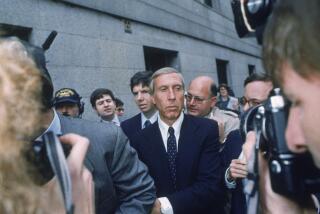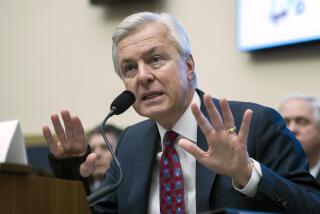Pimco Deal Stirs Questions on Setting of Industry Fines
- Share via
The Pimco mutual fund group’s $50-million settlement over federal charges of improper trading is fueling new questions about the penalties regulators are demanding in the industry scandal.
At issue are the fines and disgorgement totals regulators are ordering -- and whether they should publicly disclose how they arrive at those numbers.
As expected, the East Coast units of the Pimco group on Monday said they reached a deal to end a Securities and Exchange Commission probe into “market timing” trades in Pimco-brand stock funds in 2002 and 2003.
The Pimco bond funds, based in Newport Beach, weren’t targeted in the SEC investigation.
As part of the agreement, which The Times first reported Saturday, the Pimco group will pay $50 million, all of which will be available to reimburse stock fund shareholders who were harmed because of improper trading by Canary Capital Partners.
The SEC said Pimco struck a secret deal with Canary to allow the New Jersey-based hedge fund to engage in rapid-fire trading, or market timing, in return for large investments in other funds that generated management fees for Pimco.
Of the $50 million Pimco will pay, $40 million is a civil penalty and $10 million represents a so-called disgorgement obligation. The Pimco group agreed to the settlement without admitting or denying the charges.
Experts say disgorgement typically would include both restitution for losses incurred by shareholders and a return of ill-gotten profit. But the SEC did not specify how much investors lost or how much Pimco might have earned in total management fees paid by Canary.
The Pimco units cited by the SEC -- including PEA Capital, manager of the company’s New York-based stock funds -- on Monday repeated their claim that the damage to fund shareholders totaled $1.6 million.
PEA Capital said that figure was determined by an independent special counsel after it examined the four stock funds in which Canary traded: PEA Growth, PEA Innovation, PEA Opportunity and PEA Target.
But Randall R. Lee, head of the SEC’s Los Angeles office, said the agency believed the cost was greater than Pimco’s figure.
“We certainly don’t accept Pimco’s claim that the entirety of the damage is $1.6 million,” said Lee, whose office handled the investigation.
Lee, however, did not provide a specific amount.
The question of investors’ losses from abusive fund trading has been a subject of much debate over the last year as nearly a dozen major fund companies have settled SEC and state probes for penalties of as much as $515 million.
Some legal experts say there has been little information presented to back up assumptions that investors lost large sums from abusive trading.
“The SEC has not provided an accounting of the harm done,” said Mercer Bullard, a law professor at the University of Mississippi and a former SEC attorney.
When New Jersey regulators in May settled a separate market-timing probe with the Pimco group, they ordered the firm and its parent, German insurance giant Allianz, to pay $15 million in penalties and $3 million to cover the cost of the investigation. All of that money went to the state of New Jersey; fund investors weren’t included in the deal.
As one element in determining disgorgement and penalty totals, estimating what shareholders lost from market timing and other improper trading is more art than science, fund industry experts say.
One way that rapid fund trading costs buy-and-hold shareholders is by raising portfolio management expenses, which are borne by all investors.
In addition, short-term trading, when successful, can effectively skim fund profits from longer-term investors. But those shareholders also can benefit if a short-term trader loses money on his transactions. In that case, the trader may “dilute” the losses that would be suffered by all investors in a fund -- say, because the market overall declined.
Darren Dopp, a spokesman for New York Atty. Gen. Eliot Spitzer, who uncovered the first cases in the fund scandal, said investor loss estimates ultimately were guesswork.
The SEC’s Lee said the agency had no single formula for determining investor losses or for setting total penalties in fund cases. “There are a variety of ways that we look at it,” he said.
In the Pimco case, he said, the agency considered not just the actual harm done to investors but also the agreement between Pimco and Canary and what that might have cost investors over time “if Canary had been more successful as a trader.”
But some industry analysts say the SEC should tell more about how it decides on disgorgement and penalties.
“They should just make the data public,” said Eric Zitzewitz, a Stanford economics professor who has studied short-term trading practices in the fund industry.
“We need to know what the dollars are” in terms of investor losses, Bullard said.
The Pimco group this year returned $1.6 million to the four stock funds involved, after the independent counsel’s probe. The SEC said it would credit that against the total $50-million payment.
The SEC said an independent agent would be named to handle loss claims from investors who were shareholders of the Pimco stock funds in 2002 and 2003.
More to Read
Inside the business of entertainment
The Wide Shot brings you news, analysis and insights on everything from streaming wars to production — and what it all means for the future.
You may occasionally receive promotional content from the Los Angeles Times.










